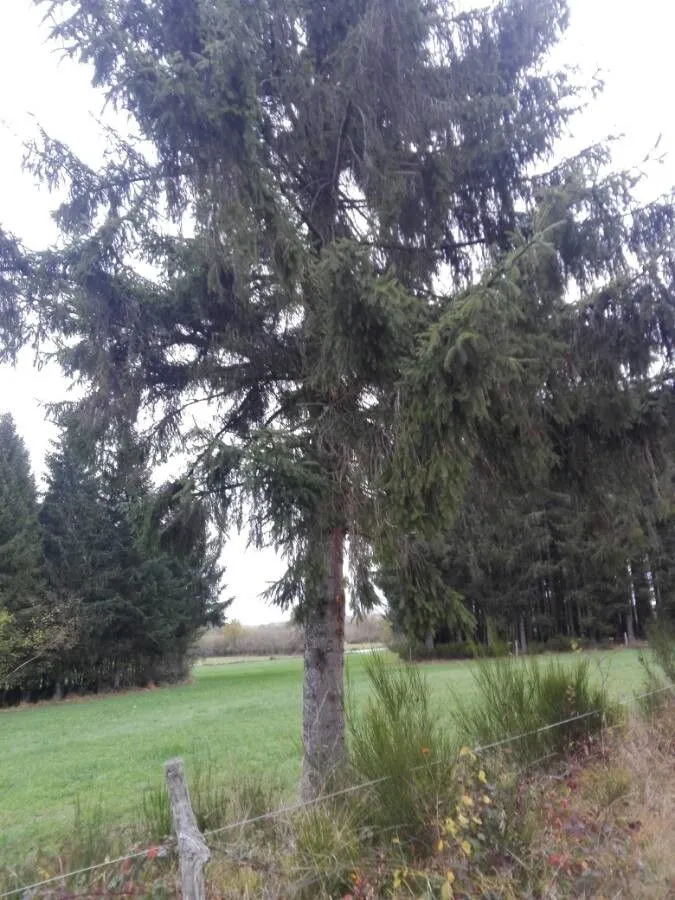
Author: Sarg.
Bibliography: Silva N. Amer. 12: 33 (1898)
Year: 1898
Status: accepted
Rank: species
Genus: Picea
Vegetable: False
Observations: E. Canada to NE. & EC. U.S.A.
The Red Spruce, scientifically known as Picea rubens, is a prominent coniferous tree belonging to the family Pinaceae. Sarg., an authority on the subject, documented this species in Silva N. Amer. 12: 33 (1898).
Native to Eastern Canada and the northeastern and eastern-central regions of the United States, the Red Spruce plays a vital role in the forest ecosystems of these areas. Its natural habitat spans from the forests of Newfoundland, through the Maritime Provinces of Canada, and extending southward through the Appalachian Mountains into the United States.
Red Spruce trees are easily identifiable by their distinctive features. They typically have a narrow, conical form and can grow up to 18-22 meters (59-72 feet) tall, with some exceptional specimens reaching even greater heights. The bark of the Red Spruce is thin, grayish-brown, and scaly, adding a rugged texture that peels off in small, circular plates.
The needles of the Red Spruce are a rich yellow-green, sharp, and roughly 12-15 mm in length. Arranged spirally around the twigs, these stiff needles contribute to the tree’s dense foliage. One of the most interesting aspects of the Red Spruce is its cones, which are slender and cylindrical, ranging from 3-5 cm long. Initially purplish, these cones mature to a reddish-brown hue and usually persist on the branches through the winter.
As an ecological cornerstone, the Red Spruce provides critical habitat and food for various wildlife species. Birds, such as the spruce grouse and the red crossbill, rely on its seeds, while mammals like red squirrels use the trees for both food and shelter.
In addition to its ecological importance, the Red Spruce also holds economic value. Historically, it has been extensively harvested for its wood, which is prized for its straight grain and high resonance, making it a preferred material for musical instruments, particularly violins and guitars. Furthermore, its wood is used in construction, paper production, and as a source of timber.
The presence of Red Spruce forests contributes significantly to the area’s biodiversity and environmental stability. However, these forests have faced challenges due to logging, environmental changes, and pest infestations. Conservation efforts are underway to preserve and restore Red Spruce populations, recognizing their importance in maintaining ecological balance and supporting various forms of wildlife.
In summary, the Red Spruce, Picea rubens, is not only a distinctive and valuable tree species but also an integral part of the forest ecosystems across Eastern North America. Its unique characteristics, ecological significance, and the challenges it faces highlight the need for continued preservation and sustainable management practices.
Deu: amerikanische rotfichte, rotfichte
Eng: eastern spruce, red spruce, yellow spruce
Nld: rode spar
Hun: vörös luc
Swe: amerikansk rödgran
Spa: picea roja, pícea roja
Ita: picea rossa
Fra: prusqueur rouge, épicéa rouge, épinette jaune, épinette rouge, epinette rouge
Rus: ель красная (el’ krasnaya)
Zho: 红云杉 (hong yun shan)
En: Red spruce, Eastern spruce, He-balsam, West Virginia spruce, Yellow spruce
Ar: تنوب أحمر
Az: Qırmızı küknar
Be: Елка чырвоная
Bg: Червен смърч
Zh: 红云杉 (hong yun shan)
Cr: Oskisk
Cs: Smrk červený
Nl: Rode spar
Et: Punane kuusk
Fi: Punakuusi
Fr: Épinette rouge, Prusqueur rouge, Épicéa rouge, Épinette jaune, Epinette rouge
De: Rotfichte, Amerikanische Rot-Fichte, Amerikanische Rotfichte
He: אשוחית אדומה
Hu: Vörös luc
Is: Brúngreni
It: Picea rossa
Kv: Гӧрд кӧз
Lv: Sarkanā egle
Lt: Raudonoji eglė
Lb: Amerikanesch Routfiicht
No: Rødgran
Pl: Świerk czerwony
Ru: Ель красная, Ель красная (el’ krasnaya)
Es: Picea roja, Pícea roja
Sv: Amerikansk rödgran
Tr: Kırmızı ladin
Vi: Vân sam đỏ
Taken Nov 20, 2022 by Alexei TAO (cc-by-sa)
Taken Mar 21, 2021 by Severin Ronald (cc-by-sa)
Taken Oct 31, 2019 by Yann Fichet (cc-by-sa)
Taken Mar 11, 2021 by june choi (cc-by-sa)
Taken Dec 28, 2021 by Steffen Christensen (cc-by-sa)
Taken Jan 1, 1900 by EOL − USDA NRCS Wetland Science Institute. (public)
Taken Jul 1, 2020 by Kasparas Bacys (cc-by-sa)
Taken Sep 11, 2004 by EOL − Steven J. Baskauf (cc-by-nc-sa)
Taken Jan 1, 1900 by EOL − Keith Kanoti, Maine Forest Service, United States (cc-by-sa)
Taken Apr 15, 2021 by Tom Atkinson (cc-by-sa)
Taken Nov 20, 2022 by Alexei TAO (cc-by-sa)
Taken Feb 20, 2021 by june choi (cc-by-sa)
Taken Jan 16, 2022 by Richard Wideman (cc-by-sa)
Taken Mar 1, 2021 by june choi (cc-by-sa)
Taken Feb 18, 2021 by brad fossen (cc-by-sa)
Taken Oct 17, 2022 by Stéphane Bonhomme (cc-by-sa)
Taken Jan 14, 2022 by Melanie B (cc-by-sa)
Taken Apr 29, 2021 by Anne-Sophie Mandy (cc-by-sa)
Taken Nov 6, 2017 by Jean Marc Montoya (cc-by-sa)
Taken Jun 13, 2019 by Gabriele Fadda (cc-by-sa)
Taken Jun 29, 2022 by bio natalie (cc-by-sa)
Taken Jun 22, 2022 by Erika schneider (cc-by-sa)
Taken Dec 26, 2019 by Joe Daley (cc-by-sa)
Taken Apr 10, 2018 by David Moreau (cc-by-sa)
Taken Dec 7, 2013 by EOL − Robert L Curtis (cc-by-nc-sa)
Taken Feb 28, 2016 by EOL − jesslinton (cc-by-nc)
Taken Jun 11, 2020 by Brandy Boyd (cc-by-sa)
Taken Feb 28, 2016 by EOL − jesslinton (cc-by-nc)
Taken Jul 12, 2020 by mustermann maxi (cc-by-sa)
Taken Jun 13, 2019 by Gabriele Fadda (cc-by-sa)
Growth form>: Single Stem
Growth habit>: Tree
Growth rate>: Moderate
Ph maximum: 5.8
Ph minimum: 4.0
Family: Myrtaceae Author: (F.Muell.) K.D.Hill & L.A.S.Johnson Bibliography: Telopea 6: 402 (1995) Year: 1995 Status:…
Family: Rubiaceae Author: Pierre ex A.Froehner Bibliography: Notizbl. Bot. Gart. Berlin-Dahlem 1: 237 (1897) Year:…
Family: Sapindaceae Author: Koidz. Bibliography: J. Coll. Sci. Imp. Univ. Tokyo 32(1): 38 (1911) Year:…
Family: Asteraceae Author: A.Gray Bibliography: Pacif. Railr. Rep.: 107 (1857) Year: 1857 Status: accepted Rank:…
Family: Fabaceae Author: Medik. Bibliography: Vorles. Churpfälz. Phys.-Ökon. Ges. 2: 398 (1787) Year: 1787 Status:…
Family: Aspleniaceae Author: (Cav.) Alston Bibliography: Bull. Misc. Inform. Kew 1932: 309 (1932) Year: 1932…